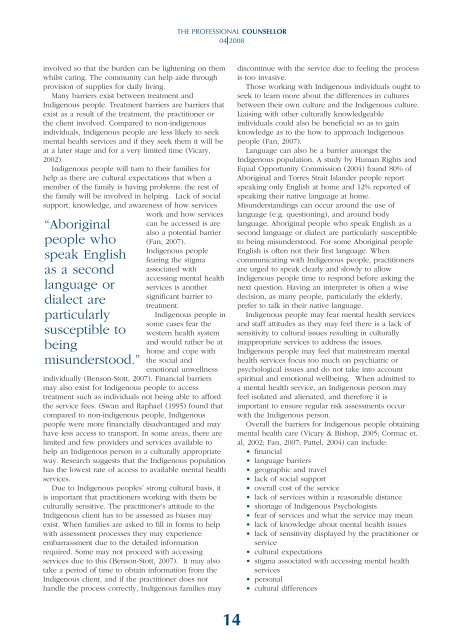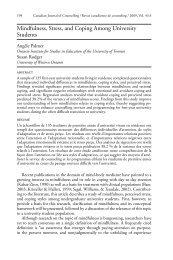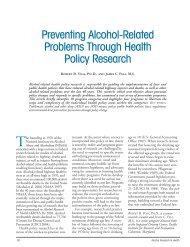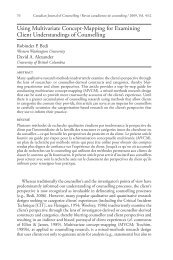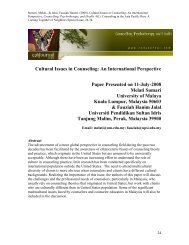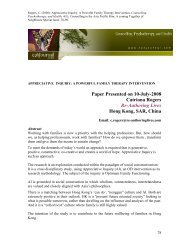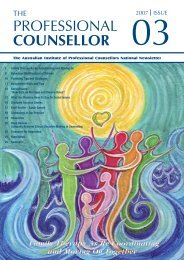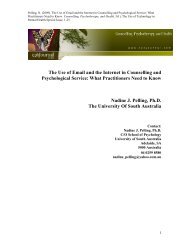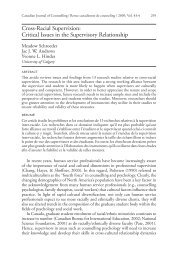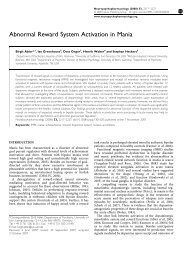Counselling Practice - Becoming a Reflective Practitioner
Counselling Practice - Becoming a Reflective Practitioner
Counselling Practice - Becoming a Reflective Practitioner
You also want an ePaper? Increase the reach of your titles
YUMPU automatically turns print PDFs into web optimized ePapers that Google loves.
THE PROFESSIONAL COUNSELLOR<br />
04 2008<br />
involved so that the burden can be lightening on them<br />
whilst caring. The community can help aide through<br />
provision of supplies for daily living.<br />
Many barriers exist between treatment and<br />
Indigenous people. Treatment barriers are barriers that<br />
exist as a result of the treatment, the practitioner or<br />
the client involved. Compared to non-indigenous<br />
individuals, Indigenous people are less likely to seek<br />
mental health services and if they seek them it will be<br />
at a later stage and for a very limited time (Vicary,<br />
2002).<br />
Indigenous people will turn to their families for<br />
help as there are cultural expectations that when a<br />
member of the family is having problems, the rest of<br />
the family will be involved in helping. Lack of social<br />
support, knowledge, and awareness of how services<br />
work and how services<br />
“Aboriginal<br />
people who<br />
speak English<br />
as a second<br />
language or<br />
dialect are<br />
particularly<br />
susceptible to<br />
being<br />
misunderstood.”<br />
can be accessed is are<br />
also a potential barrier<br />
(Fan, 2007).<br />
Indigenous people<br />
fearing the stigma<br />
associated with<br />
accessing mental health<br />
services is another<br />
significant barrier to<br />
treatment.<br />
Indigenous people in<br />
some cases fear the<br />
western health system<br />
and would rather be at<br />
home and cope with<br />
the social and<br />
emotional unwellness<br />
individually (Benson-Stott, 2007). Financial barriers<br />
may also exist for Indigenous people to access<br />
treatment such as individuals not being able to afford<br />
the service fees. (Swan and Raphael (1995) found that<br />
compared to non-indigenous people, Indigenous<br />
people were more financially disadvantaged and may<br />
have less access to transport. In some areas, there are<br />
limited and few providers and services available to<br />
help an Indigenous person in a culturally appropriate<br />
way. Research suggests that the Indigenous population<br />
has the lowest rate of access to available mental health<br />
services.<br />
Due to Indigenous peoples’ strong cultural basis, it<br />
is important that practitioners working with them be<br />
culturally sensitive. The practitioner’s attitude to the<br />
Indigenous client has to be assessed as biases may<br />
exist. When families are asked to fill in forms to help<br />
with assessment processes they may experience<br />
embarrassment due to the detailed information<br />
required. Some may not proceed with accessing<br />
services due to this (Benson-Stott, 2007). It may also<br />
take a period of time to obtain information from the<br />
Indigenous client, and if the practitioner does not<br />
handle the process correctly, Indigenous families may<br />
discontinue with the service due to feeling the process<br />
is too invasive.<br />
Those working with Indigenous individuals ought to<br />
seek to learn more about the differences in cultures<br />
between their own culture and the Indigenous culture.<br />
Liaising with other culturally knowledgeable<br />
individuals could also be beneficial so as to gain<br />
knowledge as to the how to approach Indigenous<br />
people (Fan, 2007).<br />
Language can also be a barrier amongst the<br />
Indigenous population. A study by Human Rights and<br />
Equal Opportunity Commission (2004) found 80% of<br />
Aboriginal and Torres Strait Islander people report<br />
speaking only English at home and 12% reported of<br />
speaking their native language at home.<br />
Misunderstandings can occur around the use of<br />
language (e.g. questioning), and around body<br />
language. Aboriginal people who speak English as a<br />
second language or dialect are particularly susceptible<br />
to being misunderstood. For some Aboriginal people<br />
English is often not their first language. When<br />
communicating with Indigenous people, practitioners<br />
are urged to speak clearly and slowly to allow<br />
Indigenous people time to respond before asking the<br />
next question. Having an interpreter is often a wise<br />
decision, as many people, particularly the elderly,<br />
prefer to talk in their native language.<br />
Indigenous people may fear mental health services<br />
and staff attitudes as they may feel there is a lack of<br />
sensitivity to cultural issues resulting in culturally<br />
inappropriate services to address the issues.<br />
Indigenous people may feel that mainstream mental<br />
health services focus too much on psychiatric or<br />
psychological issues and do not take into account<br />
spiritual and emotional wellbeing. When admitted to<br />
a mental health service, an Indigenous person may<br />
feel isolated and alienated, and therefore it is<br />
important to ensure regular risk assessments occur<br />
with the Indigenous person.<br />
Overall the barriers for Indigenous people obtaining<br />
mental health care (Vicary & Bishop, 2005; Cormac et.<br />
al, 2002; Fan, 2007; Pattel, 2004) can include:<br />
• financial<br />
• language barriers<br />
• geographic and travel<br />
• lack of social support<br />
• overall cost of the service<br />
• lack of services within a reasonable distance<br />
• shortage of Indigenous Psychologists<br />
• fear of services and what the service may mean<br />
• lack of knowledge about mental health issues<br />
• lack of sensitivity displayed by the practitioner or<br />
service<br />
• cultural expectations<br />
• stigma associated with accessing mental health<br />
services<br />
• personal<br />
• cultural differences<br />
14


